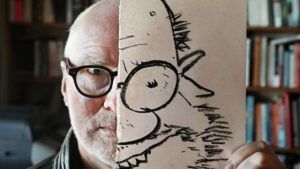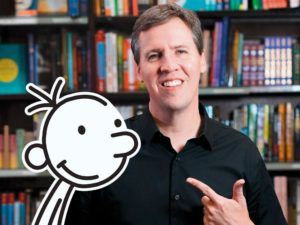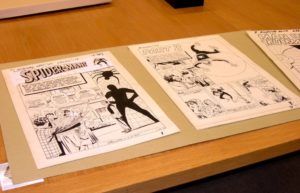Cartoonists: Bill Griffith, Tom Scott, Steve Ditko, Rube Goldberg, Jeff Kinney, Will McPhail
Skip to comments
Interview: Bill Griffith, Nobody’s Fool, and a Grand Career in Comics
In 1976, Zippy began to appear in about 50 alternative weekly newspapers–syndicated only by me. From ’76 to ’85, Zippy was a weekly strip that I syndicated alone. In 1985, the San Francisco Examiner, a daily Hearst paper, was given over to a new generation. Will Hearst III called me into his office and offered that I do a strip for the paper. I thought he meant weekly. No, he wanted daily. That was a huge shock. I remember telling him that I’d have to think about it. I came back with a proposal for six months of backlog, running my weekly archives daily to help give me time to get into the flow of doing new material. He agreed so there I was in 1985.
Then, in 1986, one of the vice presidents at King Features came down to visit me in San Francisco and proposed that King Features take on Zippy as a daily comic strip. Once again, I was very surprised. This was not something I’d sought. Right away, I didn’t think the material was going to work around the country in places like Kansas City. King Features said to let them worry about that. I thought I’d try to kill the deal by asking for a lot more money than I’d been getting from the Examiner and King Features agreed instantly. They agreed to not censor me too. Suddenly, I was in New York signing a contract and trying to show salesmen how to sell Zippy. A couple of them got it and the rest looked like they wanted to be somewhere else.
From pre-Zippy to post-Schlitzie – a Bill Griffith interview at Comics Grinder.
Oh, that post Schlitzie bit:
And I’m doing a third one now…It’s another biography. This time it’s of Ernie Bushmiller, the cartoonist who created the Nancy comic strip. It’s as much about him as it is about the world in which he operated, the late teens and early ’20s into the late ’70s and early ’80s. The world of newspaper comic strips, especially within the various New York newspapers.
Cartoonist Tom Scott Has Left the Building
Where Bill Griffith has immersed himself in comics, Tom Scott has bailed on the daily deadline to devote himself only to his new project.
Scott’s take on the state of New Zealand politics and the movers and shakers down the corridors of power has spanned almost five decades.
In amongst the daily satire offered up to newspaper readers, Scott’s creative output has been prolific.
“Tom has been a cartooning force in New Zealand. He has shone a spotlight on social issues, politics, his heroes and the underdogs. Bans from covering parliament didn’t stop him.”
His work for The Evening Post and The Dominion Post was legendary.
“He is without doubt the most talented cartoonist we have ever seen.“
Now Tom Scott is drawing himself out of the picture of daily newspaper satire to write a book.
Rube Goldberg: Facts About the Man and His Life
[Rube Goldberg] first worked for the San Francisco Chronicle from 1904 – 1905.
After that he worked for the San Francisco Bulletin from 1905 – 1907 as a sports cartoonist.
He worked for the New York Evening Mail from 1907 – 1921.
He also worked for the The New York Sun, The New York Journal and the Journal-American as an editorial cartoonist.
His work started to be syndicated in 1915 and was then picked up by McNaught Syndicate from 1922 to 1934.
Brain Power Boy relays the basic stats of Rube Goldberg.
“My Stories Are the Stories of Childhood”
[A] literary franchise that includes not just books translated into 30 languages, but merchandising and movies as well.
He was in Time magazine’s list of The World’s Most Influential People in 2009, listed as the third highest-paid author in Forbes’ 2017 list — at $21 million, and had lunches with US presidents.
For readers of about seven-plus, Jeff Kinney’s debut Diary of A Wimpy Kid was a stand-out star, offering belly-busting hilarity and a loving, light touch take on tweenage anxiety of funny little oddity Greg Heffley. For the adults it was reminder of what it was like to be a kid. A decade and a dozen books later, Kinney, who has carved out his own distinctive niche in a rich and varied landscape of children’s books, remains a permanent fixture on bestseller charts.
Gulf News profiles and interviews Jeff Kinney, the king of preteen illustrated fiction.
Lee & Ditko: Amazing Fantasy #15 (Deconstructed)
It caused quite a stir a couple of years ago when the entirety of the original artwork to AMAZING FANTASY #15, containing the very first Spider-Man story, was anonymously donated to the Library of Congress. The art was among the earliest to go missing from Marvel’s warehouse back in the late 1970s/early 1980s and nobody had seen any sign of it until this donation was made. The question of who had the artwork all this time and why they chose now to make this donation.
I don’t really want to get into the question of who donated the artwork here. Rather, the fact that the art exists in such a publicly-accessible forum gives us the opportunity to study it more closely and see what secrets we might unlock about the creation of this story.
Comics creator Tom Brevort breaks down the first Spider-Man story from the 1962 original art.
The Cartoonist Who Began by Doodling in Zoology
Cartoonist Will McPhail regularly draws for the world famous New Yorker magazine and Private Eye but a decade ago he was a distracted zoology student in Glasgow.
He admits to “doodling lecturers” when he was supposed to be learning and, despite graduating, he never sought a career in the animal kingdom.
Instead he opted to sit in Edinburgh’s coffee shops and libraries, studying the social behaviour of humans and coming up with witty cartoon ideas.
At 30, and six years on from winning Young Cartoonist of the Year, he is now expected to have between eight and 10 ideas per week for The New Yorker, a long-established American magazine.
The BBC interviews magazine cartoonist Will McPhail.






Comments
Comments are closed.